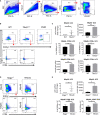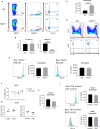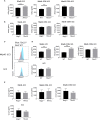T-Bet Controls Cellularity of Intestinal Group 3 Innate Lymphoid Cells
- PMID: 33603753
- PMCID: PMC7884460
- DOI: 10.3389/fimmu.2020.623324
T-Bet Controls Cellularity of Intestinal Group 3 Innate Lymphoid Cells
Abstract
Innate lymphoid cells (ILC) play a significant immunological role at mucosal surfaces such as the intestine. T-bet-expressing group 1 innate lymphoid cells (ILC1) are believed to play a substantial role in inflammatory bowel disease (IBD). However, a role of T-bet-negative ILC3 in driving colitis has also been suggested in mouse models questioning T-bet as a critical factor for IBD. We report here that T-bet deficient mice had a greater cellularity of NKp46-negative ILC3 correlating with enhanced expression of RORγt and IL-7R, but independent of signaling through STAT1 or STAT4. We observed enhanced neutrophilia in the colonic lamina propria (cLP) of these animals, however, we did not detect a greater risk of T-bet-deficient mice to develop spontaneous colitis. Furthermore, by utilizing an in vivo fate-mapping approach, we identified a population of T-bet-positive precursors in NKp46-negative ILC3s. These data suggest that T-bet controls ILC3 cellularity, but does do not drive a pathogenic role of ILC3 in mice with a conventional specific pathogen-free microbiota.
Keywords: ILCs; T-bet; innate lymphoid cells; intestinal inflammation; mucosal homeostasis.
Copyright © 2021 Schroeder, Meissl, Hromadová, Lo, Neves, Howard, Helmby, Powell, Strobl and Lord.
Conflict of interest statement
The authors declare that the research was conducted in the absence of any commercial or financial relationships that could be construed as a potential conflict of interest.
Figures





Similar articles
-
Sustained Post-Developmental T-Bet Expression Is Critical for the Maintenance of Type One Innate Lymphoid Cells In Vivo.Front Immunol. 2021 Oct 29;12:760198. doi: 10.3389/fimmu.2021.760198. eCollection 2021. Front Immunol. 2021. PMID: 34795671 Free PMC article.
-
T-bet controls intestinal mucosa immune responses via repression of type 2 innate lymphoid cell function.Mucosal Immunol. 2019 Jan;12(1):51-63. doi: 10.1038/s41385-018-0092-6. Epub 2018 Oct 24. Mucosal Immunol. 2019. PMID: 30356098 Free PMC article.
-
A T-bet gradient controls the fate and function of CCR6-RORγt+ innate lymphoid cells.Nature. 2013 Feb 14;494(7436):261-5. doi: 10.1038/nature11813. Epub 2013 Jan 16. Nature. 2013. PMID: 23334414
-
T-bet-/- RAG2-/- ulcerative colitis: the role of T-bet as a peacekeeper of host-commensal relationships.Cytokine. 2009 Oct-Nov;48(1-2):144-7. doi: 10.1016/j.cyto.2009.07.007. Epub 2009 Aug 8. Cytokine. 2009. PMID: 19666230 Free PMC article. Review.
-
Innate Lymphoid Cells and Intestinal Inflammatory Disorders.Int J Mol Sci. 2022 Feb 6;23(3):1856. doi: 10.3390/ijms23031856. Int J Mol Sci. 2022. PMID: 35163778 Free PMC article. Review.
Cited by
-
Transcription factor-driven regulation of ILC1 and ILC3.Trends Immunol. 2022 Jul;43(7):564-579. doi: 10.1016/j.it.2022.04.009. Epub 2022 May 23. Trends Immunol. 2022. PMID: 35618586 Free PMC article. Review.
-
CTLA-4 expressing innate lymphoid cells modulate mucosal homeostasis in a microbiota dependent manner.Nat Commun. 2024 Nov 4;15(1):9520. doi: 10.1038/s41467-024-51719-6. Nat Commun. 2024. PMID: 39496592 Free PMC article.
-
Controversial role of ILC3s in intestinal diseases: A novelty perspective on immunotherapy.Front Immunol. 2023 Mar 28;14:1134636. doi: 10.3389/fimmu.2023.1134636. eCollection 2023. Front Immunol. 2023. PMID: 37063879 Free PMC article. Review.
-
The emerging role of group 3 innate lymphoid cells in the neonate: interaction with the maternal and neonatal microbiome.Oxf Open Immunol. 2021 May 12;2(1):iqab009. doi: 10.1093/oxfimm/iqab009. eCollection 2021. Oxf Open Immunol. 2021. PMID: 34151271 Free PMC article. Review.
-
Food for thought - ILC metabolism in the context of helminth infections.Mucosal Immunol. 2022 Jun;15(6):1234-1242. doi: 10.1038/s41385-022-00559-y. Epub 2022 Aug 31. Mucosal Immunol. 2022. PMID: 36045216 Free PMC article. Review.
References
Publication types
MeSH terms
Substances
Grants and funding
LinkOut - more resources
Full Text Sources
Other Literature Sources
Molecular Biology Databases
Research Materials
Miscellaneous

